Mastering Dill Cultivation: A Complete Home Guide
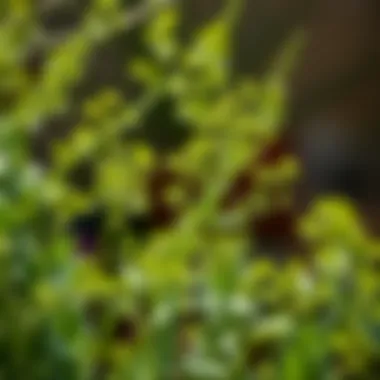

Intro
Growing dill at home can be a rewarding venture for gardeners of all skill levels. This aromatic herb is not just a culinary delight but also a great companion plant that attracts beneficial insects. Understanding how to cultivate dill involves recognizing its unique growing conditions, soil preferences, and care requirements. This guide aims to equip gardening enthusiasts with essential knowledge, from its delightful flavor to effective pest management.
Dill can be grown both indoors and outdoors, making it a versatile addition to any garden. Whether you’re looking to sprinkle fresh dill on your dishes or use it for pickling, knowing the right steps to foster its growth is crucial.
The Appeal of Dill
Apart from its culinary uses, dill is a resilient herb that adds beauty and fragrance to gardens. With its feathery green fronds and delicate yellow flowers, it’s an eye-catcher that complements various garden designs. Growing dill can be an excellent way to bring a touch of nature into your home, reflecting a commitment to both sustainability and gastronomy.
As we delve deeper into this guide, you will discover all you need to know to have a successful dill harvest and fully appreciate this remarkable herb.
Intro to Dill Cultivation
Growing dill at home is more than just a pastime; it symbolizes a connection to nature and encourages self-sufficiency. Dill, with its feathery leaves and delicate flavor, is not only a visually appealing herb but also a potent ingredient with culinary and medicinal virtues. It's essential to understand that cultivating dill creates an opportunity for enriching any dish, while simultaneously enhancing your home gardening skills.
As gardening enthusiasts embark on this journey, they often overlook the small but significant details necessary for a successful harvest. For instance, dill thrives in specific conditions that can vary widely based on location and season. Those who take the time to learn about these requirements will reap the benefits of their labors—fresh, fragrant dill right from their backyard or windowsill.
Moreover, nurturing plants like dill serves a dual purpose by contributing to an eco-friendly lifestyle. Homegrown herbs reduce reliance on supermarket produce, which often comes with a hefty carbon footprint. This section lays the groundwork for the subsequent discussions throughout this guide, arming readers with the knowledge they need to cultivate dill successfully, whether it’s in a small indoor pot or in a lavish garden.
Understanding Dill
Dill is a herbaceous annual belonging to the Apiaceae family, sharing this family with notable relatives such as parsley and cilantro. What sets dill apart, though, is its distinctive flavor profile— a touch of anise and a dash of citrus mingle to create a refreshing experience in culinary applications. Famous for pairing well with fish, particularly salmon, dill adds a layer of complexity to dishes that few other herbs can offer.
It's not just its culinary talents that make dill noteworthy. This plant is steeped in history, having been utilized since ancient times for both its flavor and potential health benefits. Dill seeds are tiny but mighty; they contain essential oils and compounds that are believed to aid digestion and may even possess antioxidant properties. It’s this intriguing mix of culinary delight and medicinal potential that has made dill a staple in various cultures around the globe.
Culinary and Medicinal Uses
When it comes to culinary applications, dill takes center stage in numerous recipes. This herb is highly celebrated in the making of pickles, blending sweet and sour to create that fan-favorite tanginess. Moreover, it features prominently in soups, salads, and sauces.
- Pickles: Dill pickles are perhaps the most recognized use of the herb. The combination of dill and vinegar results in a seasoning that’s irresistible on sandwiches and burgers.
- Soups: Adding fresh dill to soups, like potato or fish soup, can elevate a simple dish into something truly special.
- Salads: Dill complements ingredients such as cucumbers and tomatoes beautifully, making it a staple in summer salads.
In the medicinal realm, dill's reputation is not to be sneezed at. Historically, it has been used to relieve digestive issues and is also noted for its calming effects. Incorporating dill into your diet may help alleviate gas and improve overall digestion—making it a handy companion in the kitchen. Furthermore, the essential oil derived from dill has been studied for its potential anti-inflammatory properties, adding another layer to its fascinating profile.
Cultivating dill at home allows you to tap into this reservoir of benefits right at your fingertips, providing both flavor and wellness without the preservatives found in store-bought products. Understanding these nuances not only enriches your experience but also serves as a reminder of the powerful relationship between food and health.
Essential Growing Conditions
When embarking on the journey of cultivating dill, understanding the fundamental conditions that allow this herb to thrive is crucial. Essential growing conditions encompass a variety of factors, including optimal climate, sunlight, and temperature, each playing an integral role in the successful growth of dill. Without these elements being in the right balance, your efforts could lead to meager yields and a disappointing harvest.
Optimal Climate for Dill
The climate in which dill is grown significantly impacts its growth rate and overall health. Ideally, dill prefers a temperate climate with warm summers that allow it to flourish. It's a cool-season herb, meaning that it grows best when daytime temperatures are between 60°F and 70°F (15°C to 21°C). A climate that swings between warm days and cool nights is beneficial, as this fluctuation helps to enhance the flavor of the herb. More than just temperature, humidity levels also come into play; dill thrives in areas with moderate humidity. If the air is too dry, you may notice stunted growth or the herb becoming more susceptible to pests.
"Dill enjoys a happy medium; too much or too little of anything can throw it off balance."
To check whether your local climate is suitable for growing dill, you can reference resources from USDA Plant Hardiness Zone Map to see which zone you fall into and adapt your gardening plans accordingly.
Sunlight Requirements
Dill is not a sun-shy herb; in fact, it flourishes best with a healthy dose of sunlight. It requires at least 6 to 8 hours of direct sunlight each day to reach its full potential. Planting your dill in a location where it can soak up those sun rays is essential. However, while sunlight is vital, it's also important to provide some protection during the hottest parts of the day—the afternoon sun can sometimes scorch young plants.
Here are a few tips to ensure your dill gets the right amount of sunlight:
- Choose an unshaded area: Make sure no tall plants or structures block the light.
- Monitor growth: If you notice leggy plants reaching for light, they may need a sunnier spot.
- Consider using containers: Grow your dill in pots that you can move around to find the best sunlight exposure.
Temperature Preferences
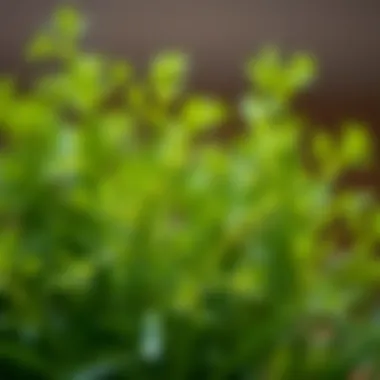
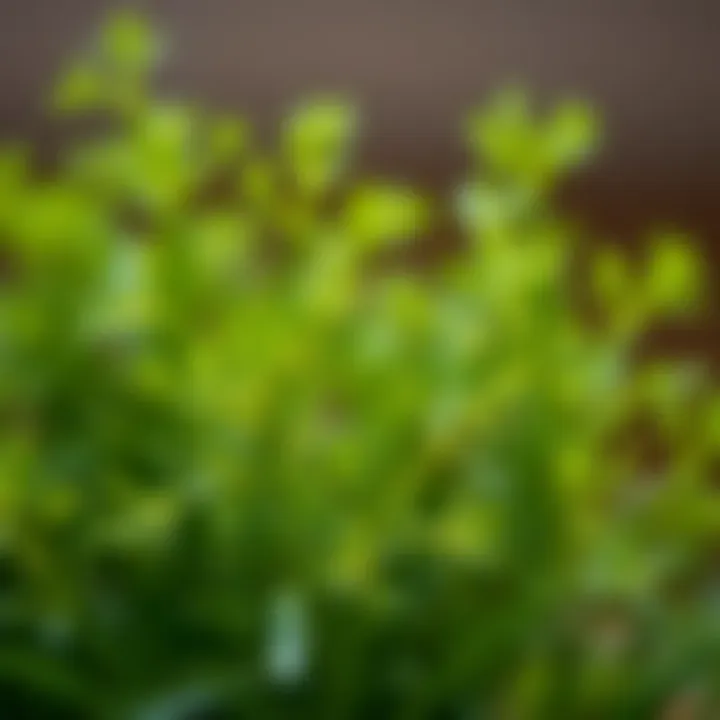
Temperature plays a critical role in the health and growth cycle of dill. While it is generally resilient, dill’s growth can stall in high heat or frost. Dill seeds germinate best when soil temperatures hover around 70°F (21°C), but once the plants are growing, they can withstand light frost. Ideally, gardeners should aim to germinate seeds in early spring or late summer for a fall harvest.
As the heat intensifies beyond 80°F (27°C), the productivity can diminish, and the plants may bolt, which is the process where they prematurely flower and go to seed. This can leave you with fewer flavorful leaves to enjoy. To mitigate high temperatures, mulching around the base can help retain soil moisture and cool the roots.
In summary, setting the stage for dill by understanding its essential growing conditions—optimal climate, sunlight requirements, and temperature preferences—will set you on the right track toward a bountiful harvest. Knowing your local environment can aid in making adjustments, allowing your dill to thrive in your garden or on your windowsill.
Choosing the Right Soil
Choosing the right soil for growing dill is a critical factor that significantly influences the plant's health and yield. Dill, though considered hardy, has specific soil preferences that must be met for optimal growth. A healthy soil environment can improve nutrient availability, enhance drainage, and support robust root development. Therefore, understanding the nuances of soil composition and other related factors is pivotal for both amateur and seasoned gardeners alike.
Soil Composition and Texture
The very structure of the soil determines how well dill plants will thrive. Ideally, dill prefers well-draining soil rich in organic matter. A loamy composition, which balances sand, silt, and clay, is often the best option. This balance helps retain moisture while allowing excess water to drain effectively. Additionally, incorporating materials like compost or well-rotted manure can improve soil texture and fertility. Composts not only enrich the soil but also introduce beneficial microorganisms that aid in plant growth.
When assessing soil texture, you might find it useful to conduct a simple texture calculation using the jar method: combine soil with water in a transparent jar, shake, and allow it to settle. The different layers formed indicate your soil texture – a vital insight for determining appropriate amendments.
pH Level and Nutrient Needs
The pH level of the soil is another cornerstone of dill cultivation. Dill generally thrives in soil with a pH ranging from 6.0 to 7.0. You can easily test your soil's pH with kits available at gardening centers or through local cooperative extensions. If your soil skews too acidic or alkaline, consider adjusting it. Lime can raise the pH, while sulfur can lower it.
Nutritionally speaking, dill has modest requirements. It benefits from a balanced fertilizer rich in nitrogen, phosphorus, and potassium. A slow-release fertilizer, applied according to the directions, can ensure that dill gets the nutrients it needs throughout its growth cycle. However, avoid over-fertilizing, as this can lead to lush foliage with little flavor – not what one wants when looking to enhance culinary dishes.
Improving Soil Quality
Improving your soil quality is not just an act; it's an ongoing adventure. Regular amendments can keep your soil in tip-top shape. Adding organic matter annually can boost both soil texture and fertility, making it a dynamic partner in your gardening endeavor.
Here's a practical checklist for improving soil quality:
- Add Organic Matter: Regularly integrate compost, leaf mold, or aged manure.
- Crop Rotation: Change the planting location of dill each season to prevent nutrient depletion.
- Mulching: Use organic mulch around your dill plants to retain moisture and suppress weeds.
- Cover Crops: Plant cover crops in the off-season to enrich the soil with nutrients and structure.
Remember, the foundation of your dill garden lies within the soil. Make it count!
Investing time and resources in understanding and enhancing your soil can offer significant returns in terms of dill growth and flavor. Keeping these considerations in mind will ensure that your dill plants flourish, leading to a bountiful harvest ready for your favorite culinary applications.
Seed Selection and Sowing
Choosing the right seeds and the proper techniques to sow them is vital for the success of your dill garden. Seed selection affects not only the growth rate but also the flavor, aroma, and resilience of the plant. Let's explore why these elements are crucial and how they can impact your dill growing experience.
Varieties of Dill
When considering dill, it’s essential to know that not all dill seeds are created equal. There are several varieties, each with its own characteristics:
- Bouquet Dill: A popular choice due to its high yield and quick growth rate. It produces tall plants with feathery leaves and is perfect for home cooks who want fresh dill in no time.
- Fernleaf Dill: Known for its compact size, fernleaf is suitable for container gardening. Its flavor is synonymous with classic dill, making it a favorite for culinary dishes.
- Long Island Mammoth: As its name suggests, this variety grows larger and produces more flowers, which appeal to pollinators. If your goal is to have an abundant herb garden, this one’s worth planting.
Imagine standing in your garden, a gentle breeze rustling through the aromatic leaves of your carefully chosen dill varieties. The right plant can enhance not only the flavor of your dishes but also the gardening experience itself.
Proper Sowing Techniques
Sowing dill involves a few key practices that can make all the difference in your harvest:
- Timing: Dill seeds should generally be sown directly into the garden bed in late spring after the last frost. In warmer climates, you can start them as early as late winter. This timing is crucial because it allows the seeds to germinate in optimal conditions.
- Soil Preparation: Before sowing, ensure that your soil is loose and well-draining. Dill thrives in a clean and nutrient-rich environment. You can mix compost into the top layer of soil to boost its fertility.
- Sowing Depth: Plant the seeds about a quarter of an inch deep. They don’t need to be buried too deeply since dill is an annual herb that prefers a light touch of soil above them.
- Spacing: Give them room to breathe. Ideally, space the seeds about 18 inches apart. Dill can spread a bit, and overcrowded plants suffer from competition for nutrients and moisture.
- Watering: After sowing, water lightly and consistently. Too much water can lead to rot, while too little can slow germination. Keep the soil moist, but not soaking wet.
"Getting the basics of sowing right can transform your dill patch from a patchy mess into a lush, aromatic oasis."
While it might seem like a straight path from seed to sprout, the details can make it a bumpy ride if neglected. Whether you're looking to spice up a meal or simply enjoy the beauty of your garden, understanding seed selection and proper sowing techniques is foundational in ensuring your dill thrives. Attention to these elements can save you from setbacks and bring an aromatic touch to your kitchen that you'll cherish all season long.
Care Practices for Growing Dill
Caring for dill requires a thoughtful approach that combines consistent attention and specific practices tailored for this herb. Proper care ensures that your dill not only thrives but also offers the rich flavor and aromatic qualities that make it a favorite in culinary circles. Being proactive about care practices means heading off potential issues before they sprout, leading to a bountiful harvest. The essence of caring for dill revolves around three main activities: watering, fertilization, and pruning. Let's delve into each element with a discerning eye.
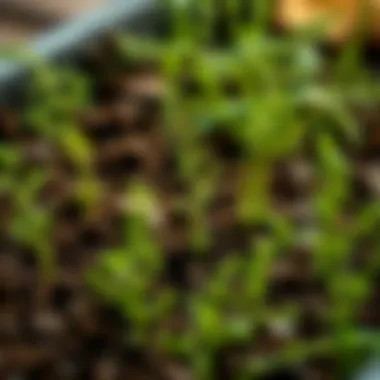

Watering Guidelines
Keeping dill well-hydrated is paramount, but it’s about striking the right balance. Over-watering can lead to root rot, while too little water will stunt growth. A good rule of thumb is to water dill when the top inch of soil feels dry. Generally, dill likes consistently moist, but not soggy, soil.
- Frequency: On average, watering dill once a week is effective. During hotter months, you might need to step it up to twice weekly.
- Irrigation: Using a drip irrigation system can be beneficial for maintaining consistent moisture levels. This is particularly useful if you have a larger garden or if the weather can be erratic.
- Observation: Pay attention to your plants; curling leaves may indicate a need for extra water, while yellowing leaves can suggest you've gone overboard.
It's important to ensure that the pots or garden beds allow for good drainage. Standing water is dill’s worst enemy!
Fertilization Approaches
When it comes to fertilizing, dill isn’t overly demanding. However, a little boost can go a long way in enhancing growth and flavor. Using a balanced fertilizer can help establish a robust root system and support healthy foliage.
- Type of Fertilizer: An all-purpose fertilizer with a balanced NPK ratio, like 10-10-10, is a solid choice. You can also consider organic options, such as compost or well-rotted manure, which enrich the soil naturally.
- Timing: Fertilization is best done every 4 to 6 weeks during the growing season. Applying before sowing seeds can give them a head start.
- Application Method: Follow the instructions carefully for application rates, and avoid over-fertilizing, which can lead to lush foliage that lacks flavor.
Throwing in some organic matter can improve soil structure and moisture retention over time. Healthy soil translates to healthy dill.
Pruning and Maintenance
Regular pruning can enhance airflow around your dill plants, reducing the risk of fungal diseases and pests. It also encourages bushier growth by prompting the plant to allocate energy towards branching out rather than simply growing taller.
- When to Prune: Start pruning once the plants reach about 6 to 8 inches tall. Remove any flower stalks as they appear, as flowering can reduce leaf quality and flavor.
- Cutting Technique: Utilizing sharp scissors or garden shears, snip off the tops of the dill stems just above a leaf node. This will stimulate branching.
- General Maintenance: Keep the planting area weed-free and fluff up the soil as needed to allow for better drainage. Keeping an eye out for pests or signs of illness can help you take action before issues escalate.
Regular upkeep is the secret sauce to maintaining robust dill plants。
By implementing these care practices effectively, you will encourage your dill to grow vibrantly, offering lush foliage and a delightful aroma that elevates any dish. Paying attention to watering, fertilization, and regular maintenance provides a solid foundation for your herb garden.
For more detailed information on herb care, consider checking sites like Wikipedia or the USDA for gardening resources.
Pest and Disease Management
Effective pest and disease management is essential for anyone looking to cultivate dill successfully. Gardeners often put a lot of effort into nurturing their plants, and facing pest or disease issues can be disheartening. Understanding what threats can affect dill and how to tackle them not only protects your dill harvest but also enhances your gardening experience. By being proactive in managing pests and diseases, you’ll establish a more resilient garden, where dill can thrive, along with other plants in your home or backyard.
Common Pests Affecting Dill
Dill, while generally hardy, can encounter a variety of pests that can compromise its health. Here are some of the most common culprits:
- Aphids: These tiny pests suck the sap from leaves and stems, leading to yellowing and curling. Their rapid reproduction rates can lead to a significant infestation if not addressed quickly.
- Cabbage Looper: This caterpillar is known for its looping movement and can consume large quantities of leaves, affecting the plant's growth.
- Spider Mites: These minuscule arachnids can cause discoloration and webbing on plants. They typically thrive in hot, dry conditions, making them a concern particularly in the summer months.
- Whiteflies: Much like aphids, whiteflies feed on plant sap, leading to reduced vigor. They often leave behind sticky residues, attracting sooty mold.
- Fleabeetles: These small, jumping beetles can create holes in dill leaves, causing damage that can leave the plant vulnerable to diseases.
Taking note of these pests and monitoring your plants regularly can help in early detection, making management easier.
Preventive Measures and Treatments
Preventing pests and diseases is all about preparation and proactive measures. Here are recommended strategies to keep your dill healthy:
- Healthy Soil: Start with nutrient-rich soil that supports plant vigor. The stronger your plant, the less susceptible it is to pests.
- Companion Planting: Growing dill alongside plants such as marigolds or garlic can deter harmful pests. These plants can repel aphids and other undesirables, acting as natural protectors.
- Natural Predators: Encouraging beneficial insects, like ladybugs and lacewings, can help manage pest populations naturally since they feed on many common pests.
- Regular Monitoring: Keep an eye on the foliage and stems of your plants. Early signs of pest activity, like holes in leaves or sticky residue, should prompt immediate action.
- Organic Treatments: Utilize organic insecticides like neem oil or insecticidal soap if pests become an issue. These treatments are effective against many pests without harming beneficial insects if used correctly.
- Cultural Practices: Rotate your crops each year to minimize pest habitations and lower the likelihood of disease cycles repeating in your garden.
"Taking a proactive stance on pest management can save you from a lot of trouble in the long run."
Implementing these measures can create a more robust environment for your dill and decrease the potential impact of pesky intruders.
Harvesting Dill
Harvesting dill is a crucial stage in the cultivation process, and it plays a vital role in determining the flavors you’ll bring to your culinary endeavors. Understanding when and how to harvest might just make or break your dill-growing experience. As with many herbs, the timing and technique of harvesting can greatly affect the taste and quality of the final product.
When you delve into harvesting, the key considerations include not only the flavors but also the health of the plant and the overall yield. Getting it right can ensure that your dill remains fresh and flavorful, whether you're using it in a culinary creation or preserving it for future use.
Identifying the Right Time to Harvest
Timing is everything when it comes to harvesting dill. Dill is usually ready for harvest when the flowers begin to form but before they bloom completely. At this stage, the leaves are vibrant, and the flavor peak is just around the corner. If you wait too long, the herb may lose some of its aromatic properties, resulting in a less intense flavor—think of it as picking cherries that are just ripe, rather than waiting for them to over-sweeten and lose their crispness.
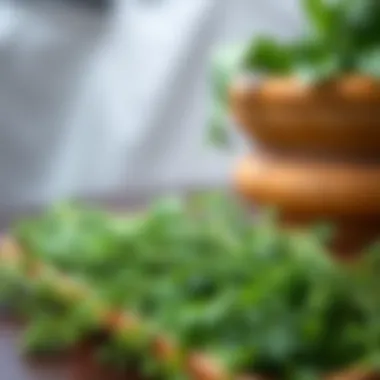

Here are some telltale signs to keep an eye on:
- Leaves are full and healthy: Look for leaves that are lush and vibrantly green, which indicates the plant is at its prime.
- Seed heads forming: When you see the heads beginning to form, it’s a clear signal that the dill is ready for a trim.
- Best before the blooms: Ideally, bite the bullet and harvest before the blooms fully open, as this shift can alter the flavor.
To put it concisely, harvesting dill at the right moment ensures that the herb maintains its rich and delightful perfume, ready to elevate your next dish.
Techniques for Harvesting
When it comes to actually bringing in your harvest, you’ve got a few choices that can preserve the integrity of the plant and maintain that fresh dill flavor.
- Use sharp scissors or shears: For cleaner cuts, opt for a pair of sharp scissors. This minimizes damage to the stems and helps the plant regenerate.
- Cut above the base: Aim for cutting just above the leaves, ideally removing a few inches of stem. This encourages new growth and allows your dill to keep thriving.
- Harvest in the morning: The best time to harvest is in the cooler part of the day, preferably early morning. This not only helps retain the essential oils but also yields firmer leaves.
- Don’t take it all: Leave a decent amount of foliage on the plant to allow it to keep growing. It’s about balance; think of it like a haircut—snip just enough for a fresh look without stripping everything down.
- Store properly: If you intend to use the dill right away, store your freshly harvested stems in a glass of water in the refrigerator to keep them fresh until you’re ready to cook. Alternatively, consider wrapping the stems in a damp paper towel before placing them in a plastic bag.
With the right techniques, harvesting your dill can become an enjoyable part of the growing experience.
Remember, a little care in the harvest can lead to a bountiful experience in the kitchen, where that fresh herb can truly shine.
Preservation and Storage of Dill
Preserving and storing dill properly is crucial for maximizing the benefits you can reap from your harvest. Fresh dill has an aromatic quality that lends itself well to many dishes. When you grow it at home, you want to ensure it stays fresh or, at the very least, edible for as long as possible. Proper storage methods help maintain flavor, color, and nutrient content, making your culinary efforts more rewarding.
When it comes to preservation, there are a few effective techniques worth considering. Depending on how you plan to use the dill later, you can choose to either dry or freeze it. Each method has its benefits, and the choice between them often depends on personal preference or the intended use in your recipes.
Drying Dill
Drying dill is one of the oldest methods of preservation, and it's simple, effective, and needs just a few supplies.
- Harvesting: Begin by gathering some of your dill stems right before the flowers start to bloom. This ensures you capture the strongest flavor before it potentially diminishes over time.
- Cleaning: Rinse them gently under running water to remove any dust or insects. Shake off the excess water.
- Drying Time: You can air dry dill by bundling several stems together and hanging them upside down in a warm, dry, and dark place. This could take anywhere from a week to ten days. Alternatively, if you're short on time, using a dehydrator cuts down drying time to a few hours.
- Storage: Once dried, crush the leaves gently and store them in an airtight container away from light. Glass jars work well, and you might even consider using a vacuum-sealed bag to keep air out.
"Dried dill can hold its flavor for up to a year, making it a great alternative for out-of-season cooking."
Drying enhances the shelf-life of your dill but be cautious—over-drying can lead to a fragile texture and loss of flavor. Monitor the drying process carefully.
Freezing Dill
If you prefer to retain that fresh-kicked flavor, freezing dill is often the go-to method.
- Preparation: Begin by washing the dill stems thoroughly, then pat them dry with a clean towel.
- Chopping: Depending on your usage later, chop the dill finely or leave the leaves in bigger sprigs.
- Freezing Method: You can freeze dill in two primary ways:
- Storage: Properly stored frozen dill can retain the quality for up to six months, though it may still be used beyond that depending on your palate.
- Using Ice Cube Trays: Place the chopped dill in ice cube trays and cover with water or olive oil before freezing. Once solid, transfer the cubes into a zip-top bag to save space in your freezer.
- Freezing Flat: Place the sprigs or chopped dill on a baking sheet in a single layer, freeze until solid, then transfer into a zip-top bag for long-term storage.
When thawed, the texture might not be the same as fresh dill, but the flavor is still potent, which makes it excellent for soups, dressings, or sauces.
The End
As we reach the end of this in-depth exploration of growing dill at home, it becomes paramount to reflect on the significance of the overall process. Cultivating dill is not merely about the end product; it's about engaging with nature and understanding its rhythms. The act of nurturing a plant from seed to harvest provides insights into patience and resilience, critical qualities not just in gardening, but in life itself.
Reflecting on the process, it's essential to recognize the numerous benefits that come with cultivating dill. From the culinary versatility it brings to your kitchen to its aromatic allure, dill can elevate your dishes and offer health benefits. Moreover, each step of growing dill—be it preparing the soil, ensuring optimal conditions, or managing pests—teaches a lesson about care and attention. This journey can turn a casual hobby into a grounding experience, fostering a deep appreciation for home gardening.
Reflecting on the Process
The journey of growing dill unfolds in manageable steps that anyone can navigate. It starts by selecting the right varieties suited to your space and climate. Remembering that nature has its timing is key; patience pays off. When you notice the tiny green leaves sprouting, a sense of accomplishment fills the air. You learn the rhythm of watering, adjusting for the right sunlight, and understanding when to add nutrients to the soil. Each observation lays the brick to a garden that not only survives but thrives.
Looking at the process holistically can be enlightening. Every phase has its challenges—disease, pests, and environmental factors come into play. However, overcoming these obstacles is part of what makes the endeavor overly rewarding. By adapting your techniques and broadening your knowledge, every setback can convert into an opportunity for growth, both for the plants and for you as a gardener.
Embracing Home Gardening
Home gardening encapsulates so much more than growing plants; it's a lifestyle choice that encourages sustainable practices and a connection with the earth. As more people seek to immerse themselves in these activities, the appeal of nurturing your own herbs like dill cannot be overstated. It's a small yet significant rebellion against the mass-produced world where ingredients are often stripped of their vitality before reaching our plates.
By embracing home gardening, you learn to curate your space, be it a sprawling backyard or a cozy windowsill. Engaging with the dirt, seeds, and sunlight turns mundane routines into meaningful rituals. Plus, growing your own dill reduces your grocery bills while offering the freshest quality straight to your table.
For more insights and information on growing herbs, you can check out resources on gardening from Wikipedia and Britannica.
"Gardening adds years to your life and life to your years."
Now that you’re equipped with the know-how, roll up your sleeves and get those hands dirty!







